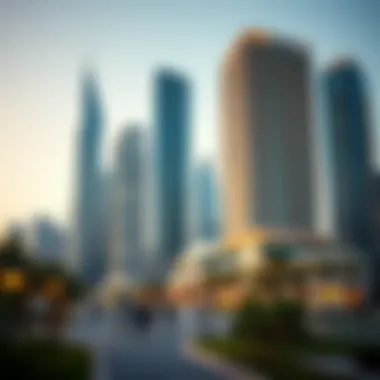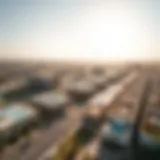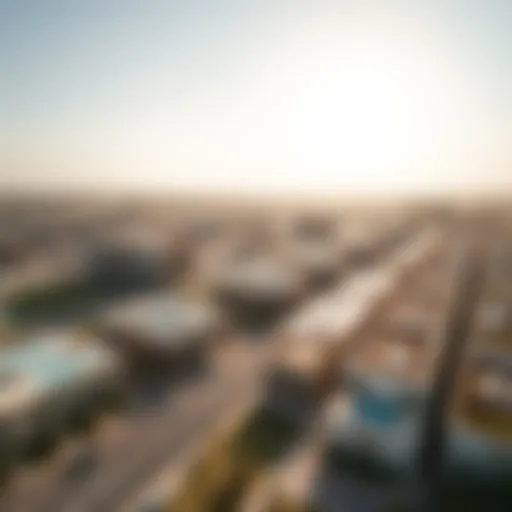Exploring Dubai's Leading Real Estate Developers


Intro
Dubai has become synonymous with luxury living, towering skyscrapers, and a thriving economy. The city’s real estate sector has seen a meteoric rise, attracting homebuyers and investors from all corners of the globe. A multitude of developers have played pivotal roles in shaping this dynamic landscape, each bringing their own unique flair and vision. Exploring the leading players is not just fascinating; it’s essential for anyone looking to navigate the intricate web of opportunities in Dubai’s market.
In this article, we will delve into the key developers that set the pace in this bustling metropolis, their standout projects, and the broader market trends affecting potential buyers and investors. By understanding these factors, we hope to equip our audience—homebuyers, investors, agents, and analysts—with the knowledge to make informed decisions in a rapidly evolving environment.
As we transition into our first main section, let’s look closer at the current state of Dubai's real estate market, understanding the nuances of pricing and future trends, and how they fit into the big picture.
Prelims to Dubai's Real Estate Development Landscape
Dubai has become a stunning example of what rapid urban development can achieve in the global real estate market. The importance of understanding the dynamics of this development landscape is evident for homebuyers, investors, agents, and analysts alike. As one of the fastest-growing cities in the world, Dubai’s real estate sector exhibits a blend of luxury, innovation, and investment potential that draws interest from around the globe.
To appreciate the full impact of Dubai's real estate sector, one must take a closer look at both its historical context and the economic significance it carries today. This exploration is not just a glimpse into fancy skyscrapers and lavish villas; it speaks to the underlying forces that shape a city and its opportunities for growth.
The benefits of delving into Dubai's real estate development are manifold. For investors, understanding the landscape provides insights into where to allocate funds wisely. Homebuyers gain knowledge on the types of properties available and their respective values. Agents find advantages in marketing strategies that align with current market trends. Analysts can predict future movements based on historical data and emerging economic indicators.
The stakes are high, and the competition to captivate both local and international clientele continues to grow. Offering a rich tapestry of investment possibilities, the real estate market in Dubai is influenced by several key factors, from governmental strategies to demographic shifts. Ultimately, this article aims to synthesize all aspects of the thriving market, highlighting the key players and trends that shape its current state.
"Understanding Dubai's real estate sector is not merely about bricks and mortar; it's about foreseeing the future trajectory of an ambitious city."
In demographic terms, the influx of expatriates and foreign investors over the past decades has catalyzed real estate growth. This influx not only insulates the market from some global economic downturns but also solidifies its status as a global business hub. Each developer brings unique contributions to this vibrant market, enhancing the architectural landscape while fostering sustainable practices and innovative technologies.
In summary, the introduction to Dubai's real estate development landscape encapsulates the mechanisms by which urban growth occurs and the opportunities it presents. In the following sections, we will explore the historical context that paved the way for this remarkable growth, as well as the economic implications for current and future stakeholders.
Key Players in the Market
In any thriving economy, the importance of key players cannot be overstated, especially in sectors that contribute significantly to growth and development. In Dubai, the real estate market is a critical pillar of the economy, influencing various aspects from job creation to infrastructure enhancement. Understanding who these key players are sheds light on the unique characteristics of this dynamic market.
Real estate developers are not merely builders; they are architects of urban landscapes, molding cities in ways that affect daily life for residents and businesses alike. The significance of delving into this segment is twofold: it assists potential investors and homebuyers in making informed decisions while also providing a clear view of market dynamics for analysts and agents. Furthermore, the strategies employed by these developers often reflect broader economic trends, delivering insights into future growth and sustainability initiatives.
Overview of Top Developers
When discussing Dubai's real estate landscape, a handful of developers stand out due to their extensive portfolios and innovative approaches. Leaders like Emaar Properties, Nakheel, DAMAC Properties, Meraas, and FAM Properties aren't just names; they are synonymous with high-value developments that range from luxurious residential spaces to commercial hubs.
- Emaar Properties: Known for its large-scale projects like the Burj Khalifa and Dubai Mall, Emaar is recognized for pushing the envelope on luxury living and lifestyle integration.
- Nakheel: Famous for developing the Palm Jumeirah, Nakheel focuses on creating iconic constructions that articulate leisure and luxury in equal measure.
- DAMAC Properties: This developer specializes in luxury offerings, targeting affluent buyers who seek exclusive living experiences.
- Meraas: Engaging with community-centric developments, Meraas seeks to blend urban living with accessible spaces for social interaction.
- FAM Properties: It emphasizes a client-centric approach, tailoring offerings that appeal to both end-users and investors.
These developers set standards in design, sustainability, and residential experience, making their influence crucial for understanding market trends.
Market Share Analysis
A deeper exploration into market shares reveals how these developers distribute their influence across various segments of the industry. It's essential to understand the proportions of market share to gauge the health and potential future of the real estate sector in Dubai. For instance, reports indicate that Emaar controls a sizable chunk, providing residential and commercial real estate on an unprecedented scale.
?> The dominance of these key players often creates barriers for smaller developers but also pushes them to innovate and find niche markets.
- An overview of market share highlights:
- Emaar Properties: Leading with approximately 30% of the residential market, contributing gravely to Dubai’s skyline and social fabric.
- Nakheel: While also powerful, Nakheel manages around 18% of the market, concentrating on geographical landmarks like the Palm Islands.
- DAMAC Properties and Meraas: Each holds around 15% and 10% respectively, excelling in high-end and community-driven projects.
- FAM Properties: Although smaller in market share, their increasing presence suggests a growing interest in client-focused strategies.
As the market landscape continues to evolve, understanding the balance of power among these developers can be key to predicting future trends, allowing investors to make informed decisions about where to focus their resources. This analysis not only underscores the competitive nature of the market but also highlights opportunities that arise from shifts in market leadership, ultimately revealing the symbiotic relationship between developers and investors.
For further insights into Dubai's real estate dynamics, visit Dubai Land Department or Global Property Guide.
Leading Developers in Dubai
The real estate landscape in Dubai is like a patchwork quilt, colorful and diverse, each section telling a story of its own. Leading Developers in Dubai serve as the artisans of this quilt, stitching together both the present and future of urban living. These developers not only construct buildings; they generate lifestyles, create value for investors, and enhance the urban environment.
Understanding the contributions of these developers is essential for anyone interested in the Dubai real estate market. Investors looking to buy property, analysts wishing to assess market trends, and homebuyers dreaming of their ideal home all need to stay informed about these prominent figures. The developers significantly shape not only the skyline of Dubai, but also its societal trends and economic cycles.
Emaar Properties
Signature Projects
Emaar Properties is synonymous with luxury and innovation in the Dubai market. Among its signature projects, the Burj Khalifa stands as a testament to architectural achievement and ambition. This skyscraper isn’t just a pretty face; it attracts millions of tourists every year and raises the profile of Dubai on the global stage.
A defining characteristic of Emaar’s signature projects is their attention to detail and integration into the community. For instance, the Dubai Mall is not just a shopping center; it’s a hub for dining, entertainment, and social interaction. Such projects are beneficial as they enhance the overall living experience for residents and visitors alike.
Moreover, the unique feature of combining commercial spaces with residential complexes has made such developments attractive for investors. Prospective homeowners or renters often favor these holistic lifestyle environments, with everything they need within close proximity, thus maximizing convenience.
Innovations and Sustainability Initiatives
Emaar is not one to rest on its laurels; the developer continuously seeks to innovate, particularly in sustainability. The Dubai Creek Harbour is one example where future developments adhere to sustainable practices, incorporating green technologies and eco-friendly designs.
The key characteristic of Emaar's innovations is their forward-thinking approach to sustainability, which appeals to environmentally conscious investors. This commitment can be perceived as a beneficial choice not just for the developer’s brand image but also for the entire market as it aligns with global sustainability trends.


In addition to environmental benefits, these initiatives can also provide cost savings in the long run for property owners, thanks to reduced utility bills and increased property values.
Nakheel
Iconic Developments
Nakheel has made waves in Dubai with its iconic developments such as the Palm Jumeirah. This man-made island has become an infamous symbol of Dubai’s ambition. The specialized engineering and visionary planning behind such projects open the doors for unique real estate opportunities.
An essential aspect of Nakheel’s developments is their cultural significance and international recognition. These projects have drawn attention from both prospective residents and investors around the world, making them a popular choice for those seeking a slice of luxury living.
A unique feature of the Palm is the blend of residential and leisure spaces, which offers a lifestyle that is hard to replicate elsewhere. However, potential buyers should consider associated maintenance fees and the exclusivity of such locations, which may pose a financial burden in the long run.
Strategic Vision and Future Projects
Nakheel is not only focused on current developments; it has a strategic vision aimed at expanding Dubai’s horizons. Future projects like Deira Islands are geared toward creating vibrant communities that can support both residents and tourists.
This future-focused approach is significant as it ensures Nakheel remains relevant in a competitive market. The key feature of their strategy is adaptability, allowing them to pivot based on market demands or global events.
Thus, Nakheel’s strategic vision will likely continue to cultivate investor confidence while promoting a sense of community among residents. The challenge here is maintaining momentum and ensuring that new projects meet high standards of quality and sustainability.
DAMAC Properties
Luxury Offerings
In a city built around extravagance, DAMAC Properties stands tall as a hallmark of luxury. Famed for projects like the DAMAC Hills, the developer offers upscale apartments and villas that attract a wealthy clientele.
The key characteristic of their luxury offerings is the unparalleled blend of opulence and lifestyle amenities, catering to buyer expectations. Many investors find DAMAC’s projects appealing due to their high-end finishes and exclusive locations.
However, buyers should weigh the high entry price against potential returns. While luxury properties may yield significant profits, they also carry higher risks if market conditions shift.
Market Position and Brand Image
DAMAC Properties holds a strong market position, evident in its aggressive marketing strategies and collaborations with high-profile brands, such as Versace and Fendi for interior designs. Their brand image reflects exclusivity and luxury, attracting buyers drawn to prestige.
The significance of this market position cannot be overstated; it solidifies DAMAC’s competitive edge. However, the luxury segment can be volatile, particularly in economic downturns, making investments in such properties a double-edged sword.
Meraas
Community-Centric Developments
Meraas stands out with its focus on community-centric developments, setting the tone for modern living in Dubai. Projects like Citywalk and Bluewaters Island demonstrate this commitment by providing lively spaces that invite social interaction.
The hallmark of Meraas projects is their purpose of fostering vibrant communities rather than just constructing residential options. Such environments are beneficial as they create a sense of belonging, a feature increasingly sought after by today’s homebuyers.
However, builders must navigate challenges of maintaining these communal elements to ensure they do not devolve into becoming just more housing developments.
Role in Urban Planning
Meraas plays an integral role in Dubai’s urban planning by adopting a holistic approach toward development. By aligning their projects with public amenities and infrastructure, they enhance the overall quality of life for residents.
This comprehensive planning approach serves as a beneficial choice as it integrates residential areas seamlessly with commercial and recreational spaces. A unique aspect of Meraas’s role is the emphasis on walkability and connectivity, promoting healthier lifestyles.
Yet, one must acknowledge the potential complications arising from rapid urban growth, where planned developments might face delays or regulatory uncertainties.
FAM Properties
Client-Centric Approach
FAM Properties has garnered attention for its client-centric approach, prioritizing customer satisfaction in every project they handle. Unlike many larger developers, FAM takes the time to understand the unique needs of each client, offering personalized services that resonate well in today’s market.
The key characteristic of their client-centric model is accessibility, which has made it a popular choice for first-time buyers and investors alike. This approach allows clients to feel more engaged in the buying process, increasing overall satisfaction.
However, while a personalized approach can enhance client experience, it may lead to challenges in scalability and efficiency during high-demand periods.
Investment Strategies
FAM Properties is known for its strategic investments, focusing on projects that yield substantial returns. They often conduct thorough market research to identify lucrative investment opportunities, ensuring they stay one step ahead in the competitive landscape.
The significance of their investment strategies lies in their risk management; FAM analyzes trends before committing, helping to mitigate investment risks. A unique feature is their emphasis on partnership with clients for transparency, which boosts investor trust.
On the flip side, such caution may slow down the pace of new project launches, possibly affecting short-term market positioning.
Emerging Market Trends


In the rapidly changing landscape of Dubai's real estate sector, identifying and understanding emerging market trends is paramount for prospective homebuyers, investors, agents, and analysts. These trends offer a window into the evolving preferences and priorities of the market, informing strategies that can gauge potential success. Keeping an ear to the ground about these movements allows stakeholders to capitalize on opportunities and mitigate risks effectively. As the dynamics shift, understanding them sheds light on the future trajectory of Dubai’s vibrant property market.
Post-Pandemic Recovery
The aftermath of the pandemic has precipitated a seismic shift in Dubai's real estate. Still, developers are finding their footing, and the market is starting to bounce back. There’s been a notable increase in demand for residential properties as people become more inclined to invest in spacious living arrangements. With remote work routines becoming more mainstream, the desire for larger homes has surged.
Moreover, international interest has reignited. Investors appear more confident, as evidenced by the revival in sales and rental activities. Many foreign nationals are now looking to Dubai for second homes or investment properties, opportunely taking advantage of lower prices influenced by the pandemic.
Sustainable Developments
With environmental awareness on the rise, developers in Dubai are beginning to prioritize sustainable initiatives. The emphasis on sustainable developments is seen as a sensible choice, reflecting consumer demand for eco-friendly housing solutions. Projects like the Sustainable City are testaments to innovation, featuring energy-efficient buildings and urban farming initiatives.
Benefits of Sustainable Developments:
- Market Appeal: These projects not only draw environmentally conscious buyers but also typically see lower operating costs for occupants.
- Regulatory Support: Local authorities are providing frameworks and incentives to encourage green construction.
However, the costs associated with sustainable technologies can initially be high, which often presents challenges for smaller developers trying to dive into this sector.
Technological Innovations
The integration of technology has become one of the most game-changing trends in real estate. Developers are leveraging cutting-edge technologies to enhance property experiences and streamline operations, giving them a competitive edge.
The Role of Smart Technology
Smart technology is transforming how properties are designed and equipped. From smart thermostats to integrated security systems, these features not only attract buyers but also add convenience. They often result in long-term savings on utility bills.
- Key Characteristic: Automation and remote accessibility to home systems enhance the living experience for residents.
- Unique Feature: Many properties now offer full home automation systems, allowing users to control various aspects of their home remotely, providing both comfort and security.
"Investing in smart technology can elevate property value and appeal significantly," explains a notable industry analyst.
However, it's important to consider that technology can be a double-edged sword. Buyers must assess whether advanced technology enhances their living experience or if the dependency on gadgets might lead to complications, especially for less tech-savvy individuals.
Virtual Reality in Property Viewing
Virtual reality (VR) is redefining property viewing, enabling potential buyers to explore homes without the need for physical visits. This technological revolution offers a more immersive experience, helping buyers envision their future homes in vivid detail.
- Key Characteristic: It allows for interactive walkthroughs, providing a comprehensive overview of the property’s layout and design.
- Unique Feature: Many agents now use VR as a standard tool in their marketing armory, thus broadening their reach beyond local markets.
One significant advantage lies in convenience; prospective buyers can visit multiple properties in a short span from the comfort of their current home. But, it's noteworthy that while VR offers an innovative approach, it cannot replicate the tactile experience of physically being in a space, potentially leading to a mismatch in expectations once a buyer finally visits the property in person.
Legal and Regulatory Considerations
Navigating the legal and regulatory landscape in Dubai's real estate market is akin to navigating a winding river; it requires careful attention and a clear understanding of the currents that shape the industry. The success of real estate developers and investors relies heavily on comprehending the laws that govern property ownership, investments, and development processes. By delving into these critical legal aspects, stakeholders can reduce risks, maximize their investment potential, and align their strategies according to the market's demands.
Understanding Dubai's Real Estate Laws
In Dubai, the legal framework surrounding real estate is both comprehensive and complex. The Emirate operates under a blend of civil law and Islamic law, and the government has introduced numerous regulations to create a transparent and secure investment climate. Key elements in this framework include:
- Property Ownership: Foreigners can own property in designated areas such as Jumeirah Beach Residence and Dubai Marina, which has spurred significant international investment.
- Freehold vs Leasehold: Understanding the difference between these two ownership structures is vital. Freehold ownership grants full ownership rights, while leasehold agreements last for a specified period, typically around 99 years.
- Registration and Title Deeds: Similar to many countries, property transactions must be registered with the Dubai Land Department, which issues title deeds that serve as proof of ownership.
- Real Estate Regulatory Agency (RERA): This body regulates the real estate sector, enforcing laws, and protecting the rights of both buyers and developers.
With these regulations in place, investors must ensure compliance to avoid potential legal pitfalls that can arise from misunderstandings of property laws.
Regulatory Bodies
Key regulatory entities play a crucial role in overseeing Dubai's real estate market and ensuring adherence to legal requirements. Each body has specific responsibilities that contribute to a stable environment for property transactions and developments:
- Dubai Land Department (DLD): The DLD is the principal authority responsible for land registration, property transactions, and maintaining records of ownership. Its aim is to ensure smooth operations in the property market.
- Real Estate Regulatory Agency (RERA): As an arm of the DLD, RERA specifically focuses on regulating the real estate industry. It sets guidelines for developers, oversees property management, and mediates disputes between parties. RERA's initiatives ensure fairness and transparency in property dealings.
- Dubai Economic Department (DED): While primarily focused on economic development, the DED also oversees business operations, which includes the registration of real estate companies and ensuring they comply with commercial laws.
Ultimately, being knowledgeable about these regulatory bodies and their functions can save time, prevent legal missteps, and empower investors to operate confidently in the dynamic Dubai property sector.
Understanding the intricacies of legal and regulatory considerations in Dubai’s real estate landscape is not merely advantageous; it is essential for anyone looking to invest or develop in this vibrant market. Failure to grasp these laws can lead to costly mistakes, while those who do engage with the system effectively position themselves for success.
Investment Opportunities and Risks
Investment opportunities in Dubai's real estate market are as abundant as sand on its beaches. However, potential investors must tread carefully, navigating a landscape that is exciting yet fraught with risks. Understanding these opportunities and the associated pitfalls is crucial for anyone looking to dive into this burgeoning market.
Real estate has always been a key pillar of Dubai’s economy, attracting both local and international investors. One of the main highlights is the exceptional Return on Investment (ROI) that properties in Dubai can offer. According to various reports, rental yields in Dubai can range from 5% to 10%, which is significantly higher than in many Western markets. Understanding how to analyze ROI effectively can set the tone for a profitable venture.
Moreover, property prices have seen a steady incline in recent years, presenting a unique opportunity for capital appreciation. Whether one is eyeing residential luxury flats or commercial spaces, the prospect of fluctuating market dynamics can often invite curiosity and caution.
Nevertheless, it is crucial to also consider the risks involved, as they can be quite significant.
Analyzing ROI in Dubai Property


To truly grasp the potential for profit, understanding how to analyze ROI in Dubai property is essential. In simplistic terms, ROI is calculated by taking the net profit from the investment over a specific period and dividing it by the initial cost of investment. This gives prospective buyers a clear picture of how much they can expect to earn versus how much they invest.
For instance, a property bought for 1 million AED that generates an annual rental income of 80,000 AED has an ROI of 8%. This is considered quite attractive, especially in conjunction with the property’s appreciation potential.
- Factors influencing ROI include:
- Location and demand in specific areas.
- The condition of the property and necessary renovations.
- Economic factors, such as the overall health of Dubai's economy and tourism industry.
Investors should also keep in mind the long-term trends when analyzing ROI. Properties in sought-after areas, for instance, have historically delivered better returns due to their high rental demand.
Risks to Consider
Despite the allure of hefty returns, the Dubai real estate market comes with its own set of risks that shouldn’t be overlooked. Understanding these risks lays the groundwork for a solid investment strategy.
Market Fluctuations
Market fluctuations represent the uncertainty that can arise due to various external and internal factors affecting property values. The key characteristic of market fluctuations is their unpredictability. Prices can soar one year and dip the next, influenced by factors such as changes in government policies, economic downturns, or shifts in market demand.
- Increased Supply: As new projects launch, the oversupply can lead to saturated markets and decreased prices.
- Economic Factors: Global economic influences and financial crises can shift investor sentiment dramatically, impacting rental and sales prices.
It’s crucial for investors to keep a close eye on these trends and to seek guidance from real estate analysts and agents who have a finger on the market’s pulse.
Legal Challenges
Legal challenges are another vital aspect of risk to consider when investing in Dubai's real estate market. The key characteristic of legal challenges often lies in the complexity of property laws in the UAE, particularly for foreign investors. Whether it’s navigating freehold versus leasehold properties or understanding the nuances of ownership rights, legal intricacies can be daunting.
Some unique features of these challenges include:
- Regulatory Changes: As policies evolve, what was once permissible may change, potentially impacting ownership and investment strategies.
- Dispute Resolution: Investors must be aware that property disputes can arise, and understanding the legal framework around dispute resolution in the UAE is essential.
Investing in real estate in Dubai can be a minefield without the right knowledge. Therefore, consulting with legal experts or established agencies can help navigate these waters.
"In the world of real estate, what goes up doesn’t always have to come down, but it certainly can be a wild ride!"
Future Outlook of Dubai's Real Estate Market
In an ever-evolving market like Dubai's real estate, understanding the future outlook is paramount for potential investors, homebuyers, agents, and analysts alike. This section aims to navigate through anticipated trends while emphasizing why this information is crucial for those invested in the Dubai property saga. With the backdrop of a recovering economy and sustainable development initiatives shaping the future, discerning the upcoming landscape can uncover actionable insights for decision-making.
The nexus between developers and innovation will significantly influence market dynamics. Anticipating what lies ahead helps investors strategize their moves wisely, while homebuyers gain clarity on the best opportunities for long-term gains. Having a clear sight of growth areas and what developers are planning is akin to having a roadmap in an ever-competitive field.
"In Dubai, the skyline is not just built; it is continuously reinvented. Understanding future trends is like holding a crystal ball to navigate this transforming realm of real estate.”
Anticipated Growth Areas
The Dubai real estate market is poised to expand in several key areas. Understanding these anticipated growth zones can provide investors with ample opportunity to maximize their returns. Some of the remarkable prospects include:
- Dubai Creek Harbour: With plans for a vibrant waterfront setting, this area stands to feature residential, retail, and recreational spaces all intertwined. The new Dubai Creek Tower is expected to become a centerpiece, positioning the development for significant interest.
- Dubai South: Often referred to as the future city, this area is designed around the Al Maktoum International Airport. Its purpose is interconnectivity, presenting opportunities in residential real estate as well as commercial infrastructures.
- Meydan: Known for its lavish villas and equestrian-themed developments, it is attracting investors who favor a luxury lifestyle. The expansion and development plans here include new community centers and facilities that enhance the living experience.
- Expo 2020 Areas: Post-expo, many constructed zones around the Expo site will be repurposed for residential and commercial use. This shift is expected to create new enclaves for living, connecting with the global audience that visited the event.
Moreover, the UAE's focus on long-term residency options, such as the Golden Visa, adds another layer of appeal to these growth areas. As the nation works to attract foreign talent and investment, it inevitably creates a fertile ground for the real estate market.
The Role of Developers in Shaping the Future
As the skyline transforms, the role of developers in cultivating the future cannot be overstated. Key developers not only influence the architectural aesthetics of Dubai but also mold the very fabric of its communities. They are tasked with balancing innovation and sustainability with market demand.
- Innovative Practices: Developers have begun focusing on environmentally friendly structures that utilize smart technology, showcasing features like solar energy and efficient waste management systems. This aligns their projects with a global trend towards sustainability, which is appealing to today's conscientious buyers.
- Affordable Housing Initiatives: In response to the increase in demand for affordable living options, many developers are pivoting their strategies to include projects that cater to this critical segment of the market. Creating more inclusive offerings resonates well with the diverse population of Dubai.
- Mixed-Use Developments: A growing trend in the renewing landscape is the concentration on mixed-use projects, combining commercial and residential spaces. This approach effectively addresses the lifestyle needs of residents, enabling them to work, live, and play within their neighborhoods.
The developers' foresight in adopting adaptive strategies showcases their commitment to not only meet current demands but also anticipate future trends, thereby solidifying their position in a competitive market. As investors and homebuyers analyze these evolving dynamics, it becomes essential to recognize how these shifts can impact their respective strategies as they navigate Dubai's vibrant real estate ecosystem.
For additional insights into the current landscape of Dubai’s real estate market, consider visiting Dubai Land Department and Gulf News Property.
End
As we wrap up our exploration of Dubai's prominent real estate developers, it's important to emphasize the relevance of this topic from multiple dimensions. The intricate web of influences that these developers wield shapes not only the skyline of this vibrant city but also the broader economic landscape. Understanding their roles is key for several stakeholders, including investors, homebuyers, and real estate agents, who seek to navigate the waters of this robust market efficiently.
Summarizing Key Insights
Throughout the article, we've traversed the journey of Dubai's real estate development scene, shedding light on the various players who contribute significantly to this evolution. Here are some core insights:
- Prominent Developers: We highlighted the main developers, such as Emaar Properties and Nakheel, known for their ambitious projects and transformative impact on urban life.
- Sustainable Growth: A growing emphasis on sustainability has emerged, showing how developers are integrating eco-friendly designs and practices into their projects, which is vital for long-term viability.
- Technological Innovations: Smart technologies are becoming a cornerstone in the sector, enhancing not just the living experience but also operational efficiency within the properties.
These key points illustrate a dynamic sector that is constantly evolving, influenced by both local and global trends.
Implications for Investors and Homebuyers
For investors and homebuyers, the insights gathered from this article carry significant weight. Understanding the landscape of Dubai's real estate market can yield numerous benefits:
- Investment Potentials: Identifying leading developers and their ongoing projects can guide informed investment decisions. Properties backed by reputable developers often ensure better long-term returns.
- Market Trends: Keeping abreast of emerging trends—like sustainable developments—allows investors to forecast future values and make strategic investments.
- Regulatory Awareness: Awareness of legal and regulatory frameworks can safeguard against potential risks in property transactions, aiding in smoother investments.
In a city characterized by ambition and opulence, the role of real estate developers is not just about buildings; it's about creating a future where communities thrive.
For further reading on the Dubai real estate sector, you can visit Wikipedia for a broader historical context or check out Britannica for insights into the region's economic landscape.



